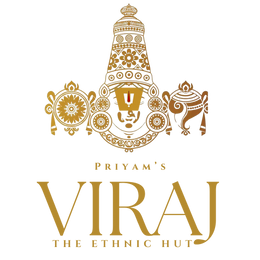Introduction
In India, a saree is more than attire—it is a legacy passed from mothers to daughters, a canvas of culture, and a timeless statement of elegance. But in 2025, the market is filled with machine-made sarees that look similar to authentic handlooms at first glance. The result? Buyers often feel confused, wondering if what they purchased is truly handcrafted or just a power-loom imitation.
A pure handloom saree carries with it centuries of tradition, human skill, and individuality. No two handloom sarees are ever exactly alike, while machine-made ones are mass-produced with mechanical perfection but without soul.
This guide will help you understand the differences between handloom and machine-made sarees while introducing you to authentic pieces from Viraj The Ethnic Hut, where heritage and artistry meet.
1. The Weave—Imperfect Yet Authentic
-
Handloom: Slight irregularities, thread knots, or uneven motifs are not flaws but proof of human touch. These irregularities make each saree unique.
-
Machine-made: Flawless, identical designs. All sarees look the same, without individuality.
Example: Indigo Blue Patola Saree – ₹5,150.
Its geometric motifs may show minor variations, a hallmark of authentic double ikat weaving.
Explore more: Patola Collection
2. The Fabric—Feel the Luxury
-
Handloom: Breathable, soft, adapts to the body, and ages beautifully. Ideal even for summer wear.
-
Machine-made: Stiff, overly glossy, or synthetic feel. Lacks breathability and grace.
Example: Zari Tussar Pure Silk Saree with Handpainted Floral Design – ₹7,999.
Tussar’s raw texture and golden sheen are impossible to replicate with machines.
Explore more:Tussar Collection
3. The Pallu & Border—Where Craftsmanship Shines
-
Handloom: Pallus and borders are often woven separately with intricate artistry.
-
Machine-made: Pallus and borders look identical to the body, lacking distinct detail.
Example: Seaweed Green Chanderi Kanjivaram Silk Saree – ₹13,800.
Its zari pallu and border showcase traditional skill.
Explore more: Kanjivaram Collection
4. Time & Price – Effort Equals Value
-
Handloom: Takes weeks or months, using natural dyes and artisan skill. Pricier but heirloom-worthy.
-
Machine-made: Quick, mass-produced, and lower priced, but lacking legacy.
Example: Polychromatic Handpainted Pen Kalamkari Silk Saree – ₹9,500.
Each motif is hand-painted, making it a true labor of love.
Explore more: Kalamkari Collection
5. Motifs & Patterns—Stories in Every Thread
-
Handloom: Motifs inspired by mythology, nature, and tradition. Each design has meaning.
-
Machine-made: Often replicas of popular patterns with no cultural depth.
Example: Sindoori Red Pure Banarasi Semi Khaddi Georgette Saree – ₹2,999.
Its Mughal-inspired zari jaal tells stories of heritage.
Explore more: Banarasi Saree Collection
6. Certification – Proof of Authenticity
-
Handloom: Comes with Silk Mark or Handloom Mark certification.
-
Machine-made: Usually lacks certification.
Example: Sandalwood Gold Pure Hand-Woven Tissue Silk Saree – ₹6,999.
Certified handwoven, giving you peace of mind.
Explore more: Tissue Silk Collection
7. The Drape Test – Grace in Motion
-
Handloom: Drapes fluidly, adapts with pleats, and feels weightless.
-
Machine-made: Often rigid, heavy, or less fluid due to synthetic blends.
Example: Wine Bandhani Modal Silk Saree – ₹4,999.
Its lightweight drape is perfect for festive evenings.
Explore more: Bandhani Collection
Quick Buyer’s Checklist
-
Check for weaving irregularities.
-
Feel fabric texture for warmth and softness.
-
Look for distinct callus and borders.
-
Ask for certifications (Silk Mark, Handloom Mark).
-
Buy only from trusted platforms like Viraj The Ethnic Hut.
Why Choose Handloom Over Machine-Made?
-
Cultural Pride – Every saree carries a story of Indian heritage.
-
Sustainability—Natural dyes and fibers reduce environmental impact.
-
Exclusivity—No two handloom sarees are identical.
-
Artisan Support—Your purchase sustains livelihoods.
FAQs
Q1: How can I tell if a saree is handloom or machine-made?
Check for weaving irregularities, natural texture, and certifications like Silk Mark.
Q2: Are handloom sarees worth the higher price?
Yes. They are durable, heirloom-worthy, and culturally rich.
Q3: Which sarees should I invest in first?
Start with versatile classics: a Banarasi for weddings, a Tussar for office wear, and an Ajrakh for casual occasions.
Q4: Do all handloom sarees come with certificates?
Not all, but reputable sellers like Viraj provide certified collections wherever applicable.
Q5: Where can I buy authentic handloom sarees online?
You can explore Viraj The Ethnic Hut, which curates handcrafted sarees directly from artisans.
Conclusion
Owning a handloom saree is about embracing six yards of tradition, craftsmanship, and pride. Machine-made sarees may look tempting at lower prices, but they can never replicate the artistry, comfort, or cultural significance of authentic handlooms.
At Viraj The Ethnic Hut, every saree is sourced directly from skilled weavers, ensuring you invest in true heritage. Whether you choose Banarasi, Patola, Tussar, or Ajrakh, your saree will always tell a story worth cherishing.
Start your journey with authentic handloom weaves today. Explore our Saree Collections.





